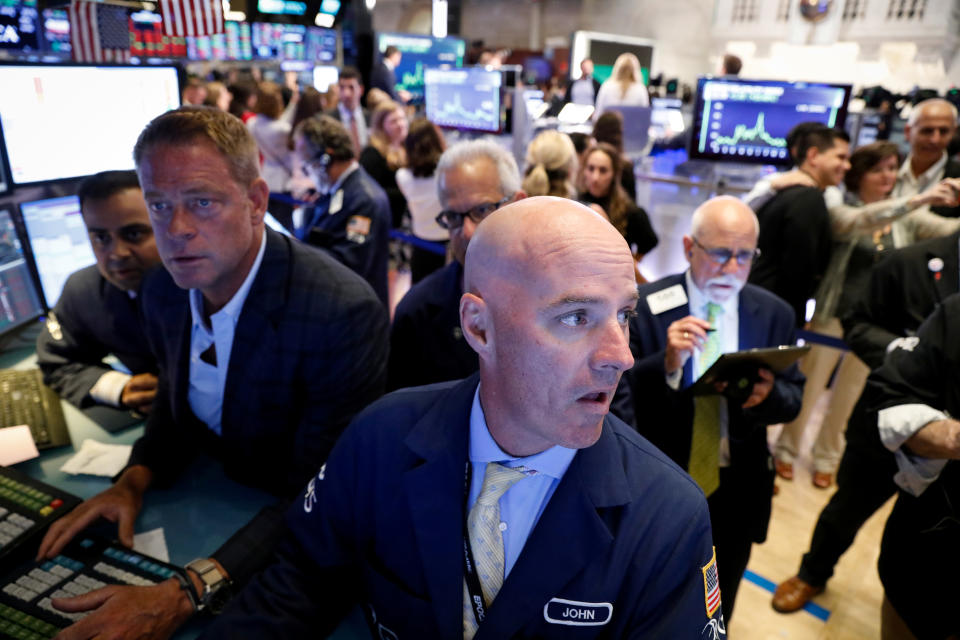Stock market news: August 2, 2019
U.S. stocks dropped Friday amid the latest escalation of the U.S.-China trade war, and as traders considered what a mostly in-line report on the state of the domestic labor market in July might imply for the Federal Reserve’s next policy move.
Here were the main moves in the market, as of market close.
S&P 500 (^GSPC): -0.73%, or 21.51 points
Dow (^DJI): -0.37%, or 98.41 points
Nasdaq (^IXIC): -1.32%, or 107.05 points
10-year Treasury yield (^TNX): -4.5 bps to 1.847%
U.S. dollar index (DX-Y.NYB): -0.29% to 98.09
The S&P 500 and Nasdaq each closed out their worst weeks of the year after President Donald Trump on Thursday unexpectedly announced he would be slapping a 10% tariff on $300 billion worth of Chinese imports not currently subject to duties. The announcement sent the three major stock indices – which had each been up more than 1% at one point Thursday afternoon – sliding into market close.
The measure will take effect September 1, adding to the $250 billion worth of Chinese goods already subject to a 25% tariff.
China “strongly opposes” the U.S. plan, and “will have to take necessary countermeasures to defend its interests,” a spokesperson for China’s Ministry of Commerce said Friday.
Trump’s announcement came even after delegations from the U.S. and China met in Shanghai this week for a round of discussions that the White House characterized as “constructive.” The two sides are set to meet again in September.
“The announcement by President Donald Trump of further tariffs on Chinese imports has rattled the markets, but we have long suspected that it was only a matter of time before the trade dispute escalated further,” Andrew Hunter, senior U.S. economist for Capital Economics, wrote in a note. “With those tariffs likely to have a more serious impact than previous measures, this reinforces our view that economic growth will slow sharply over the second half of this year.”
Amid ongoing and volatility-stirring geopolitical uncertainty, data on the domestic economy has largely taken a back seat. But a steady stream of mostly positive reads on the U.S. economy has nevertheless been promised to remain a source of fodder for officials in the Federal Reserve as they consider the path toward future monetary policy.

The Bureau of Labor Statistics released the first jobs report of the second half of the year Friday at 8:30 a.m. The U.S. economy added slightly fewer jobs than expected in July, while the unemployment rate held a hair above a 50-year low.
Non-farm payroll additions moderated to 164,000 in July, from a downwardly revised 193,000 in June. The unemployment rate held at 3.7%, instead of edging down to a 50-year low of 3.6%, as had been expected. Wage gains, however, unexpectedly rose over last year by 3.2%, higher than the 3.1% pace expected.
“The latest escalation of trade tensions and the fear that it will hurt confidence, put up costs, damage supply chains and make business less inclined to invest and hire new workers will continue to drive market sentiment,” James Knightley, chief international economist for ING, wrote in a note. “Nonetheless, a strong domestic jobs market helps to mitigate the threat to activity in the near term.”
Friday’s jobs report comes amid results from other surveys – including ADP/Moody’s estimates-beating print on private payrolls – that hinted at persistently strong employment trends. And recent results in consumer sentiment surveys from the Conference Board and University of Michigan were buoyed as respondents considered the tight labor market.
Meanwhile, earnings results from energy company Exxon Mobil (XOM) and Restaurant Brands (QSR) were released ahead of the opening bell Friday. Exxon Mobil’s quarterly profit topped consensus expectations, and upstream liquid production grew 8% from a year earlier, driven by production in the oil-rich Permian Basin. The company’s upstream business was also boosted by higher average oil prices in the second quarter versus the first.
Restaurant Brands exceeded expectations amid better-than-expected sales at Burger King and Popeyes. Comparative same-store sales at its Tim Hortons businesses, however, lagged consensus estimates.
—
Emily McCormick is a reporter for Yahoo Finance. Follow her on Twitter: @emily_mcck
Read more from Emily:
Netflix’s 2Q global paid subscriber additions miss expectations
Tech companies like Lyft want your money – not ‘your opinion’
Follow Yahoo Finance on Twitter, Facebook, Instagram, Flipboard, LinkedIn, and reddit.
Read the latest financial and business news from Yahoo Finance